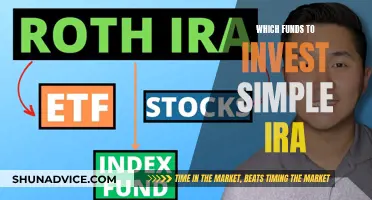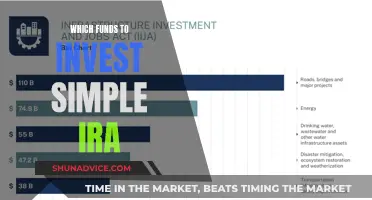
Fidelity's target date funds are a set it and forget it retirement savings option that removes two headaches for investors: deciding on a mix of assets and rebalancing those investments over time. Target date funds are designed to age with you by automatically rebalancing your portfolio from growth investments toward more conservative ones as retirement nears. Fidelity Freedom Funds help take the guesswork out of investing for retirement. Each fund invests in a mix of different types of assets, offering growth potential while helping to reduce risk. Fidelity's investment team gradually shifts and regularly rebalances the asset mix of each fund, providing a hassle-free way to invest.
What You'll Learn

Fidelity Freedom Funds
Fidelity has been managing the Freedom Funds since 1996 through a range of market cycles. During this time, they have developed a strategy that allows investors to potentially benefit from both a disciplined approach to fund management and the experience and judgment of their fund managers.
The main advantage of Fidelity Freedom Funds is their simplicity. They provide a complete portfolio in a single investment, making them ideal for those who don't have the time, expertise, or interest in building and adjusting a diversified investment portfolio.
A Smart Guide to Index Funds S&P Investments
You may want to see also

Diversification and asset allocation
When investing in target funds, it is important to understand the different asset classes available and how they can be combined to create a well-diversified portfolio. The three main asset classes are stocks, bonds, and cash or cash equivalents. Stocks typically offer the greatest potential for growth but also come with higher risk. Bonds are generally less volatile than stocks but offer more modest returns. Cash and cash equivalents are the safest investments, offering lower returns.
To build a diversified portfolio, investors should look for investments with returns that don't usually move in the same direction or to the same degree. This helps ensure that even if one part of the portfolio is declining, other parts are likely to be growing or at least not losing value. Diversification can also be achieved within each asset class. For example, when investing in stocks, it is important to own multiple stocks across different company sizes, sectors, and geographies.
Asset allocation, on the other hand, involves determining how much of each asset class to include in the portfolio. This decision is based on factors such as the investor's risk tolerance, investment horizon, and financial goals. For example, an investor with a long time horizon until retirement may allocate a larger portion of their portfolio to stocks to capture their higher growth potential. In contrast, an investor saving for a teenager's college education may favour bonds and cash equivalents due to a shorter time horizon and lower risk tolerance.
It is important to note that diversification and asset allocation do not guarantee profits or protect against losses. However, they can help manage risk and improve returns for the chosen level of risk. Regular rebalancing of the portfolio is also crucial to ensure that the asset allocation remains aligned with the investor's goals and risk tolerance over time.
Mutual Funds: Where Are Your Investments Going?
You may want to see also

Fidelity's investment team
The investment team at Fidelity is committed to helping investors succeed and feel confident in their financial decisions. They provide ongoing support, guidance, and advice to ensure that investors' strategies remain aligned with their goals.
India's Best Investment Funds: Where to Invest?
You may want to see also

Fidelity's target date glide path
Fidelity Freedom Funds are target date funds that provide a complete portfolio in a single investment. Each fund invests in a mix of different types of assets, offering growth potential while helping to reduce risk. Fidelity's investment team gradually shifts and regularly rebalances the asset mix of each fund, providing a hassle-free way to invest.
The "target date" of a target date fund is the anticipated year of retirement, and each of Fidelity's 14 Freedom Funds has a year in its name. For example, someone who is currently 22 and plans to retire at 65 might choose a target date 2065 fund. As investors approach retirement, target date funds gradually become more conservative, increasing their allocations to bonds, cash, or cash equivalents.
The mix of assets that adjusts throughout the life of the fund is known as the glide path. Fidelity's glide path is designed to meet the varying needs of investors, offering a choice of active, blend, and index target date funds with competitive fees. While the specific details of Fidelity's glide path are not publicly available, the general principles of target date fund glide paths can be observed in other providers' funds.
For example, a target date fund may begin with a heavy mix of domestic and global equity funds, constituting 90% of the total investment. By the time the investor retires, equity funds may make up only 30% of the total investment, with the remaining 70% consisting of fixed-income investments such as bonds and short-term funds. This shift towards more conservative investments as the target date approaches is a key feature of target date funds.
Matthew Ridley's Guide to Hedge Fund Investing
You may want to see also

Fidelity's target date participant communications program
- What is a target date fund?
- How do I choose the right one for me?
- What are the potential benefits of investing in a target date fund?
The program provides resources to educate and inform participants about the target date investment options available through their workplace savings plan. These resources can be used individually or as part of a more comprehensive engagement plan.
- Awareness resources: These are designed to raise awareness and inform participants prior to plan adoption. They can be shared via internal communication channels such as newsletters, intranets, and blogs.
- Conversion E-Book: This resource informs participants about new offerings, detailing when changes will take effect, what options are available, and how to make any necessary adjustments.
- Emails: Targeted emails are sent to specific participant populations to raise awareness and encourage them to learn more about the target date investment options.
- Participant Microsite: An educational digital hub with a range of materials in engaging formats to cater to various participant preferences and learning styles.
- Overview Flyer: Participants can learn about the potential benefits of Fidelity's Target Date Strategies and how to choose the right one for their retirement needs. The flyer is available in English and Spanish.
- Participant Infographic: This resource provides a deeper dive into how Fidelity's Target Date Strategies work, with examples of investors at different stages of their savings and retirement journey. The infographic is also available in English and Spanish.
Exchange Traded Funds: Investing in India's Future
You may want to see also
Frequently asked questions
Target funds with Fidelity are designed to simplify investing for retirement. They are diversified, professionally managed, and can be a hassle-free way to invest. Fidelity is an industry leader in target date investing and has been managing target date portfolios since 1996.
Choose a Fidelity Freedom Fund based on the year you expect to retire. You don't need to adjust your asset allocation over time because Fidelity Freedom Funds become more conservative the closer you get to retirement.
Potential investors should note that no target date fund is intended as a complete retirement program and there is no guarantee that any single fund will provide sufficient retirement income. The fund's share price fluctuates, which means you could lose money by investing in the fund, including losses near, at, or after the target retirement date.







